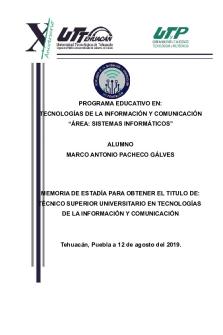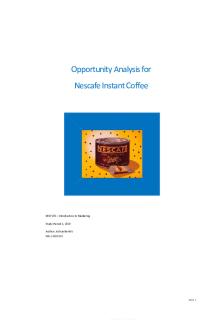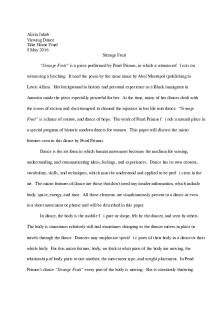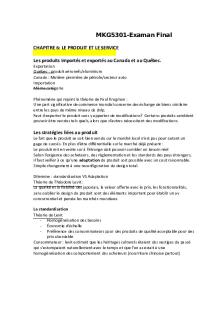Chem1010 Final F2015 PDF

| Title | Chem1010 Final F2015 |
|---|---|
| Author | jinesh modi |
| Course | Introductory Chemistry I |
| Institution | Memorial University of Newfoundland |
| Pages | 12 |
| File Size | 228.6 KB |
| File Type | |
| Total Downloads | 36 |
| Total Views | 135 |
Summary
This is a summary of the final exam of the fall semester of 2015...
Description
MEMORIAL UNIVERSITY OF NEWFOUNDLAND St. John's, Newfoundland and Labrador Chemistry 1010 December 14, 2015 FINAL EXAMINATION
TIME: 2.5 hours
NAME:
STUDENT NUMBER:
Instructor/class: (circle)
Poirier 8am
Hattenhauer 10 am
Reardon 2 pm
READ THE FOLLOWING CAREFULLY. 1.
This examination has 11 pages of three sections. SECTION A is “fill in the blank”, SECTION B is short-answer and SECTION C is long-answer questions. Ensure that this examination paper is complete, i.e. that all pages are present.
2.
Failure to submit this paper in its entirety at the end of the examination may result in disqualification.
3.
A Periodic Table and physical constants are provided. These follow the last page of the examination and may be detached for use during the examination.
4.
Answer each question in the space provided. Should you require more space, use the back of the previous page and indicate clearly where this has been done.
5.
When answering questions in all SECTIONS, show all relevant calculations and justify simplifying assumptions.
6.
Numerical answers should be reported to the appropriate number of significant digits. Do not write in the enclosed area below. Questions
Value
Section A
30
B1, B2, B3
12
B4, B5, B6
15
B7, B8
9
C1
7
C2
8
C3
6
C4
7
Mark
C5
6
Total
100
Page 1 of 11
Section A “Fill in Blank” Questions You should allow ~ 40 min for this section. Each question is worth 2 marks. A1.
How many ns are in 16 ms? Answer:
A2.
If the number of moles of gas is doubled at constant temperature and volume, the pressure of the gas will Answer:
A3.
A4.
Determine whether each salt will form a solution that is acidic, basic or neutral. NaF
Answer:
NH4Br
Answer:
What is the molecular formula of a compound with an empirical formula of HCO2 and a molar mass of 90.0 g · mol–1? Answer:
A5.
Write the equation that represents the reduction half reaction for the following redox reaction: Cu(s) + 2 AgNO3(aq) → 2 Ag(s) + Cu(NO3)2(aq) Answer:
A6.
Write the reaction that represents the enthalpy of formation for Ca(NO3)2(s)
Answer: A7.
A balloon contains 0.76 mol N2, 0.18 mol O2, 0.031 mol He and 0.026 mol H2 at a total pressure of 744 mm Hg. What is the partial pressure of O2? Answer:
A8.
What is the name of the compound with the formula N2O4? Answer:
A9.
Calculate the [OH-] for a solution with a pH=11.23:
Answer:
Page 2 of 11
A10. Round off 00907506 to four significant figures. Answer: A11. Write the expression for the equilibrium ionization constant of a weak acid HA. Answer:
A12. What is the concentration of formaldehyde (CH2O, MM= 30.0259 g mol–1) in a solution containing 0.225 g of formaldehyde in 1.0 L? Answer:
A13. Given the following balanced equation, if the rate of Cl2 loss is 4.84 × 10-2 mol L-1 s-1, what is the rate of formation of NOCl? 2 NO(g) + Cl2(g) → 2 NOCl(g) Answer:
A14. Without performing complex calculations, determine the order of a reaction that has the following initial rates for the specified starting concentration:
Answer:
A15. Express the equilibrium constant (K) for the following reaction: Na2S(aq) + Cu(NO3)2(aq) ⇌ NaNO3(aq) + CuS(s)
Answer:
Page 3 of 11
SECTION B
SHORT ANSWER QUESTIONS
SHOW ALL CALCULATIONS
Allow ~ 70 min to complete
[4]
B1.
A solution of sulfuric acid was made by diluting 20.00 mL of concentrated 12.0 mol L–1 sulfuric acid with water to give a total volume of 0.250 L. Calculate the concentration of the diluted acid.
[4]
B2.
The K for the reaction below is 1.49 × 108 at 100.0 °C: CO(g) + Cl2(g) → COCl2 (g) In an equilibrium mixture of the three gases, PCO = PCl2= 2.22 × 10-4 bar. Find the partial pressure of the product, phosgene (COCl2).
[4]
B3.
Consider the following reaction and equilibrium constant at a particular temperature. Determine the equilibrium concentration of CO2(g) if the equilibrium concentration of NH3 = 2.9 × 10-3 mol L-1. NH2COONH4(s) ⇌ 2 NH3(g) + CO2(g)
K = 1.58 × 10-8
Page 4 of 11
[6]
B4. Consider the following two-step mechanism for a reaction: Step 1: NO2 (g) + F2 (g)
→ FNO2 (g) + F (g)
Step 2: NO2 (g) + F(g)
→
FNO2 (g)
Fast
a) What is the overall reaction? [2]
b) Identify the reactive intermediate(s) in the mechanism. [2] c) "What is the predicted rate law for the overall reaction?" [2]
[6]
B5. For the following oxidation-reduction reaction: Cu(s) + 2 AgNO3(aq) → 2 Ag(s) + Cu(NO3)2(aq) (a) Element oxidized Change in oxidation #
from
to
from
to
(b) Element reduced Change in oxidation #
(c) The reducing agent is
Slow
Page 5 of 11
[3]
B6. The reaction of CO (g) and I2O5 (g) is described by the equilibrium shown below. 5CO (g) + I2O5 (g) ⇌ I2 (g) + 5CO2 (g)
∆rH° = -20 kJ mol–1
Indicate whether the following changes increase, decrease or not change the yield of I2 (g). Change in Condition
Yield of I2 (g)
(a) Increase the temperature (b) Decrease the volume (c) Adding a catalyst
[4]
B7. A sample of a diatomic gas has a mass of 9.271 g. Its volume at STP is 5.54 L. Calculate its molar mass and determine the identity of the gas.
[5] B8.
Calculate the amount of heat (in kJ) necessary to raise the temperature of 47.8 g benzene by 57.0 K. The specific heat capacity of benzene is 1.05 J g-1 °C-1.
Page 6 of 11...
Similar Free PDFs

Chem1010 Final F2015
- 12 Pages

Course Outline F2015 CSCI1040U
- 5 Pages

CHEM1010 \"cheat sheet\"
- 2 Pages

BMAT 230 Test 1 Vretta Review F2015
- 13 Pages

Final
- 9 Pages

Tesina-Final reevisado Final
- 55 Pages

🎄🎄🎄🎄🎄🎄 - Final
- 2 Pages

Opportunity Analysis final final
- 12 Pages

Examen final bioquímica final
- 12 Pages

THESIS FINAL FINAL
- 84 Pages

Final
- 3 Pages

Final
- 16 Pages

Final
- 37 Pages

Flipped-final - FLIPPED FINAL
- 6 Pages
Popular Institutions
- Tinajero National High School - Annex
- Politeknik Caltex Riau
- Yokohama City University
- SGT University
- University of Al-Qadisiyah
- Divine Word College of Vigan
- Techniek College Rotterdam
- Universidade de Santiago
- Universiti Teknologi MARA Cawangan Johor Kampus Pasir Gudang
- Poltekkes Kemenkes Yogyakarta
- Baguio City National High School
- Colegio san marcos
- preparatoria uno
- Centro de Bachillerato Tecnológico Industrial y de Servicios No. 107
- Dalian Maritime University
- Quang Trung Secondary School
- Colegio Tecnológico en Informática
- Corporación Regional de Educación Superior
- Grupo CEDVA
- Dar Al Uloom University
- Centro de Estudios Preuniversitarios de la Universidad Nacional de Ingeniería
- 上智大学
- Aakash International School, Nuna Majara
- San Felipe Neri Catholic School
- Kang Chiao International School - New Taipei City
- Misamis Occidental National High School
- Institución Educativa Escuela Normal Juan Ladrilleros
- Kolehiyo ng Pantukan
- Batanes State College
- Instituto Continental
- Sekolah Menengah Kejuruan Kesehatan Kaltara (Tarakan)
- Colegio de La Inmaculada Concepcion - Cebu

